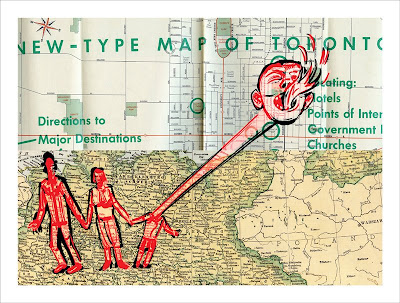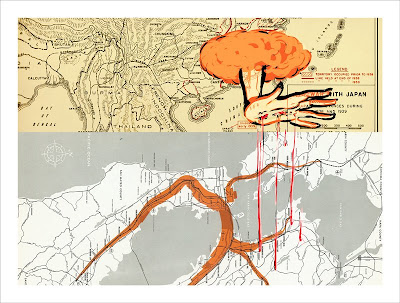The Mapping Project
Navarrete x Kajiyama & Element Dance Theater
SF International Arts Festival, Fri-Sun June 6-8, 8pm, $20 (tickets here)
As a part of “The Mapping Project” performance, coming to CounterPulse June 6-8, I’m creating some digital prints that illustrate stories that come from some of the dancers. We’ve interviewed the dancers about the experiences of their grandparents, relating to the second world war. Going back two generations, the family lines of these Bay-Area based dancers get flung pretty far, geographically: the stories touch on, among other things, the bombing of Frankfurt, the Japanese occupation of China, a kind of pilgrimage to Jerusalem, and the Japanese internment Camps at Rowher and Tule Lake. Most of the maps that form the backgrounds of the prints were scanned from the collection of the Prelinger Library, an absolutely wonderful resource on 8th street. Anyone who’s even remotely bookish is bound to have a great time there.
Below are two of the five prints, and their accompanying stories. If you’d like to see the full suite of five, visit the blog I’ve set up for the performance: themappingproject.blogspot.com
Anna’s story
My family lived in Frankfurt while it was being bombed. There was an air raid and the family went down to go to the shelter. But my dad, he was about seven, he didn’t want to go. He got absolutely hysterical about it, screaming that he didn’t want to go. They gave up, and went back to their house. And found out, the next day, that the shelter had suffered a direct hit. Everyone in it had died. Dad doesn’t like to talk about this. Whenever Oma talked about it, her voice would get full of emotion, quivering, almost crying. That seemed to be one of the reasons Dad didn’t like to bring up the war – it would make Oma very emotional. He didn’t want us to learn German. I didn’t understand all the implications. I knew my grandfather was in the army, but Oma said he wasn’t in the Nazi army, he was in the “other” army. It wasn’t until much later, somehow this came up with my boyfriend, who was Jewish. I told him my Opa was in the other army, and he said “Anna, there was no other army.” And a little light went off in my head.
Kristen’s story
The main story I remember about the war was how my grandmother’s sister had been forced to kneel and crawl over broken glass by Japanese soldiers. There were many other hardships under the Japanese occupation. They tried not to eat meat unless they slaughtered it themselves. The rumor was that the meat sold at the market was actually human flesh since the Japanese took all the livestock. There were other stories—Japanese fighter planes shooting down family villages, best friends being shot down and killed in plain sight. But the story about Po-Po’s sister crawling on broken glass—that one haunted me. How could anyone do something so cruel to another person? Every time I see broken glass on the sidewalk, I think about how it would feel to have shards of glass pierce and tear into the flesh of my knees and palms.
It was that broken glass story that made me as a child understand why Po-Po hated Japanese people for so long. Funny thing is, I actually remembered the facts of that story wrong. It turns out it wasn’t the Japanese who made Po-Po’s sister crawl on glass. It was actually the Chinese communists during the Cultural Revolution. Actually, I didn’t hear the story directly from Po-Po. It was my mother who told me. I had asked her why Po-Po didn’t like the Japanese. It’s funny, in school the kids assumed that being Chinese and Japanese were the same thing. There was one Japanese boy in my class, and the other kids assumed the two of us—me being the only Chinese girl—would get married. Now my grandfather, he was in the U.S. at the time of the war. He would have been sent to Normandy as a soldier, but he got out of it. He spoke both Chinese and English, but when he got drafted, he pretended he didn’t know any English. That way he wouldn’t be sent into battle. You might think he’d want to get in there, to fight the Japanese, but he pulled one over on the army instead. It was more important to him to stay alive. He ended up stationed in Arizona and worked as an army cook.
Share This!
More Good Stuff
QUAKE is an upcoming solo performance at CounterPulse by Kat Gorospe Cole centered around mental health and ancestral connection. Exploring within what seedkeeper Rowen White
A little over a year ago, ABD's Artistic Director Anne Bluethenthal opened one of our weekly Skywatchers meetings by asking: Who has your back? And
Seth and Remy - Photo by Adam Paulson By Seth Eisen In 2006 after Remy Charlip had a stroke I was given the





Let me start by saying that I love critical response/constructive criticism, so I’m always trying to spread that type of discourse. Saying one loved the piece, and that it was great, is great to hear and encouraging however unhelpful in a tangible way. Thank you to all the parties involved in this project, the piece was though inspiring.
The gallery was great; it really got my mind thinking about a variety of topics that were touched upon in this work. The stories, out of context, are also very intriguing especially with the accompanying visual art. My friend and I were reading the story that included the words “the other army”, which we talked about quite a bit before the show began.
The opening section, which occurred in the front of the building, was very hard to see because the performers just started performing before everyone was outside and could see them. I spent most of that opening trying to see over someone’s head and out the door.
My favorite part of this piece was the building of the house structure and the interactions with it. When the people moved in and out of the house frame and when the frame was moved by dancers around the space were both very interesting. I also was very into how this affected the shadows against the projections on the walls.
Of the ensemble, I thought everyone did a great job. One dancer seemed a little out of place though, the one with what seemed to be reddish or pinkish highlights. I felt like as beautiful as her movement was, it was not right for this piece. She seemed too serious mostly in the facial expression, but also in the body) about what she was doing physically, and not very involved in what was going on as a whole. At CounterPULSE, you have to take into account that everyone in close to the stage, so minor facial expressions and eye details matter a lot more than at SF Ballet. The others, however, played to the personal atmosphere much better. I thought that the woman wearing the kimono was very good. Her movement was so clear and well executed; it was very physically narrative, so much so that I felt like I was being told a story while she danced. Everyone else also did a good job, movement wise, I just was not very interested in the movement so it was hard for me to stay focused enough to give thorough dance critique.
The projections were good; they mimicked a lot of the positive things I saw in the gallery. I wish it would have been taken further and more was done with the images on the walls; though the images were connective to the gallery, they didn’t expand much – feeling redundant a little. The sound was okay as well, not my favorite element.
The text spoken aloud was great, I just wish there was more… I know people always want to make sure when combining dance and spoken word that they aren’t too talky or seem too forced; nonetheless, this piece was not talky enough in my opinion. I would have liked text going on more as the dancers were moving.
Thanks
Thanks for taking the time to write some impressions. It’s always interesting to hear the sorts of responses the audience has. Particularly with a piece that was created so collaboratively — while all the collaborators worked hard to share collectively in a vision that drove the piece, at a certain point, all those minds and bodies begin to create their own momentum, and it stops becoming a case of trying to realize a preordained set of ideas. Instead, it becomes a sort of moveable investigation of a series of ideas and notions, and the performers and choreographers are a kind of audience themselves, examining the piece to see what sorts of revelations might tumble out.
I’m glad you liked some of the connections between the gallery artwork and the projections, even if you felt some of that was redundant. I was hoping to play with memory, to a degree — to bring some of the images and phrases back into the theater, as fragments or scraps. Since so much of the piece deals with memory (and its imprecisions), I liked the idea of impelling the audience to “remember” the stories in the gallery, while at the same time denying them access to the full stories and images — set aside, once the theater doors were closed, in another room. Of course, it might’ve been more ideal (if fundamentally impractical) to expand the time between having the audience read the stories and see the performed part of the piece, so that the memories would have more time to fade and distort.
It’s also good to hear you found the iterations of the house satisfying. If we develop the piece further, that’s an element we might play with more. We were very fortunate to have Ilya’s sculpture as the central piece of “stage design.” If it wasn’t quite another performer in the ensemble, it was certainly another character (one that we roughed up a little, though it never complained).
Interesting that you didn’t find the piece “talky” enough. We went back and forth, as far as the degree of spoken text we wanted to use in the piece. We toyed with having the full text of the stories performed on stage, and also with eliminating text entirely, so that the gallery would’ve been a deliberately discursive space, and then the theater space would have been the non-discursive space of a dream. We ended up somewhere in the middle, which I was ultimately happy with — the halfway point between story and dream being the zone of memory, perhaps.